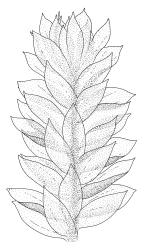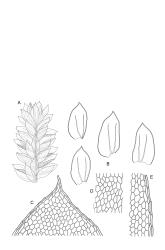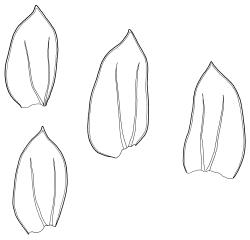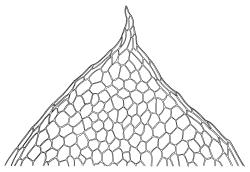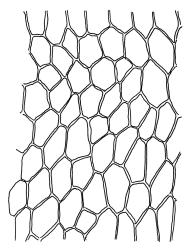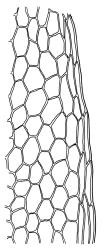- ≡ Hookeria blumeana Müll.Hal., Syn. Musc. Frond. 2, 676 (1851)
- = Hookeria lepida Mitt., Trans. & Proc. Roy. Soc. Victoria 19: 78 (1882)
- ≡ Cyclodictyon lepidum (Mitt.) Broth. & Watts., Proc. Linn. Soc. New South Wales 43: 561 (1918)
- = Hookeria karsteniana Broth. & Geh., Öfvers. Finska Vetensk.-Soc. Förh. 35: 52 (1893)
- ≡ Cyclodictyon karstenianum (Broth. & Geh.) Broth., Nat. Pflanzenfam. [Engler & Prantl] 1(3), 934 (1907)
Plants bright green, iridescent when fresh and when dry, forming mats or "hanging curtains" in irrigated situations. Stems green, to at least 35 mm, in cross-section lacking a central strand and differentiated cortical cells; rhizoids absent or nearly so. Shoots moderately complanate, c. 3 mm wide. Leaves inserted in 6 ranks, crisped when dry, broadly ovate, tapered to a broadly acute or weakly cuspidate apex, nearly plane, weakly denticulate above, bordered throughout by 2–3 rows of narrow and thin-walled cells, 1.6–2 × c. 1 mm. Upper laminal cells laxly hexagonal, moderately thin-walled, 45–60(–90) × 24–30(–39) µm, becoming more oblong, laxer, and longer towards insertion; marginal cells thin-walled, c. 125–150 µm at mid leaf; alar cells not differentiated. Costae double, slender, extending c. ¾ the length of the leaf, with or without terminal spicules. Pseudoparaphyllia foliose, lanceolate, to c. 0.4 mm.
Synoicous or monoicous fide Streimann (1997). Perigonia scattered on main stems, with bracts ovate-lanceolate, to c. 0.75 mm, weakly costate and bordered. Perichaetia and sporophytes not seen in N.Z. material.
Brotherus 1925, fig. 602; Whittier 1976, fig. 77; Streimann 1997, fig. 8.
K (Ravine 8, Western Spring, and Lava Point Spring).
Western Pacific, also in tropical Asia. Reported from eastern mainland Australia, southeast Asia (widespread there) and the Pacific Islands (Streimann 1997; Tan & Robinson 1990, p. 11).
In permanently wet conditions in seepages on Raoul I., where it was first collected by Carol West in June 1993. P. de Lange (pers. comm., June 2009) describes the Western Spring population as abundant "on basaltic breccia in a permanently dripping seepage and amongst Alocasia brisbanensis roots. Also covering chicken mesh, plastic pipes, and a plastic bucket. When fresh [it is] dark black-green, [in] sodden curtains across rock face and hanging free at ends. New growth [is] bright, iridescent emerald green; each curtain once clear of silt supports numerous other bryophytes and algal material. [The] most common associates are Lejeuneaceae, Heteroscyphus allodontus, H. argutus, Radula sp., and Fissidens rigidulus var. rigidulus." Material from Ravine 8 apparently came from a similar dripping wet, dark, breccia wall where it was associated with roots of Metrosideros kermadecensis, Adiantum cunninghamii, and plants currently referred to Blechnum norfolkianum, as well as the bryophytes Distichophyllum microcarpum, Achrophyllum dentatum, Fissidens ?rigidulus, Riccardia vitiensis, and Heteroscyphus argutus. The one collection from Lava Point Spring was associated with "taro roots".
The combination of iridescent plants, lax leaf cells, and the well-developed double costae make this species unmistakeable in a N.Z. context.
Cyclodictyon blumeanum is rated "nationally critical" in the 2010 review of threatened bryophytes by the N.Z. Department of Conservation (Glenny et al. 2011). Peter de Lange (pers. comm., June 2009) considers this species to be merely a naturally uncommon component of the Raoul I. flora. De Lange also considers that the Western Spring populations could be threatened in the long-term by Alocasia growth. The species is widely distributed outside N.Z.
The Australian C. lepidum (Mitt.) Broth. & Watts has been placed in synonymy here (Streimann 1997). At least some Australian material (in CHR) differs from Kermadec Is material by having more strongly toothed upper leaf margins, larger and more numerous costal abaxial spicules, and a stouter acumen. Streimann (1997) also synonymised C. karstenianum (Broth. & Geh.) Broth. Both these names have types from the Bellenden Ker Range in Queensland.



